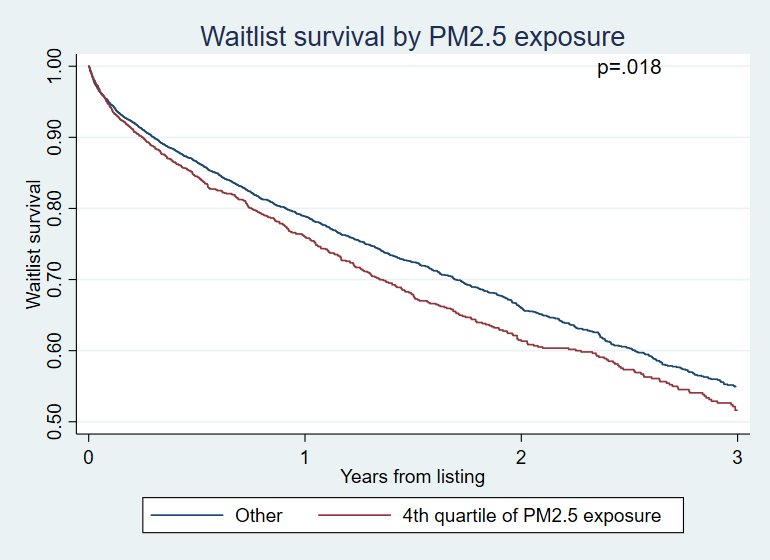Ambient Air Pollution and Waitlist Mortality among Lung Transplant Candidates
1Department of Surgery, Johns Hopkins School of Medicine, Baltimore, MD, 2Department Epidemiology, Johns Hopkins Bloomberg School of Public Health, Baltimore, MD
Meeting: 2020 American Transplant Congress
Abstract number: 84
Keywords: Lung, Waiting lists
Session Information
Session Name: From Bench to Community to Bedside in Lung Transplantation
Session Type: Oral Abstract Session
Date: Saturday, May 30, 2020
Session Time: 3:15pm-4:45pm
 Presentation Time: 3:39pm-3:51pm
Presentation Time: 3:39pm-3:51pm
Location: Virtual
*Purpose: Previous studies suggested that air pollution is associate with higher risk of respiratory diseases and accelerated decline in lung function among general population. However, few studies have examined the effect of fine particulate matter (particles <2.5μm in diameter [PM2.5]) among the population with advanced stage pulmonary diseases. Here we seek to investigate the association between PM2.5 and waitlist mortality among lung transplant candidates.
*Methods: Lung transplant candidates listed between January 1st 2010 and December 31st 2016 were identified from Scientific Registry of Transplant Recipients. PM2.5 concentrations for 2010-2016 were obtained from NASA’s SEDAC Global Annual PM2.5 Grids. Annual PM2.5 concentration at the year of listing was estimated at each participant’s zip code. We estimated crude and multivariate adjusted hazard ratios (95% confidence intervals [CI]) for waitlist mortality using Cox proportional hazards regression with robust variance.
*Results: Among 16603 candidates with PM2.5 exposure, median age at listing was 59, 44.4% were female and 81.1% were non-Hispanic white. The median zip code PM2.5 concentration was 8.94µg/m3. When compared to those who were living in the zip code with lower PM2.5 exposure (PM2.5 <10.53µg/m3), candidates living in zip codes in the highest quartile of PM2.5 exposure (PM2.5 ≥10.53µg/m3) had 1.11 (95%CI 1.01-1.20) times higher hazard of waitlist mortality. The result remained significant after further adjusted for demographics, SES, smoking, disease type, lung allocation score, blood type and life support status at listing [HR 1.12(95%CI 1.02-1.23)].
*Conclusions: In this population of lung transplant candidates, exposure to PM2.5 was associated with increased risk for waitlist mortality. These findings highlight the importance of considering the contribution of environmental exposures, such as ambient air pollution to long-term outcomes of lung transplant candidates.
To cite this abstract in AMA style:
Feng Y, Jones MR, Chu N, Segev D, McAdams-DeMarco M. Ambient Air Pollution and Waitlist Mortality among Lung Transplant Candidates [abstract]. Am J Transplant. 2020; 20 (suppl 3). https://atcmeetingabstracts.com/abstract/ambient-air-pollution-and-waitlist-mortality-among-lung-transplant-candidates/. Accessed December 17, 2025.« Back to 2020 American Transplant Congress

